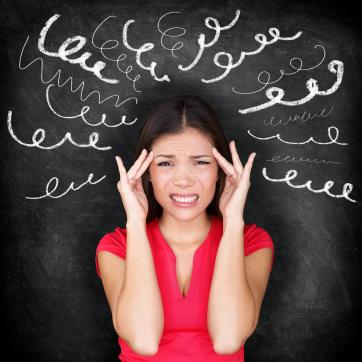 Do you ever find yourself stressed during the holiday season? You're not alone! Research by Consumer Reports reveals that 90% of Americans suffer from at least one stressor during the holiday season. With December filled with increased cooking, traveling, and shopping, it's no surprise that this season can take a toll on our emotional systems. While stress is often easy to manage in the short-term, extended stress can cause one to become vulnerable to a myriad of serious health problems. For instance, stress affects one's breathing--whether one begins breathing faster, feeling shortness of breath, or hyperventilating--the respiratory system goes into over-drive. Over time, continued strain on this system can make one more susceptible to upper-respiratory infections. One's immune system is also threatened by long-term stress. Continued stress can leave one more susceptible to infection and skin conditions such as eczema, hives, and acne. Other health outcomes from prolonged stress can be found at WebMD. Because stress so greatly affects our emotional and physical health, it is necesseary to stay on top of stress during the holidays. Here are the four primary holiday stressors: cooking, travel, family, and work.Below are some strategies you can use to cope with each of the primary holiday stressors!
Do you ever find yourself stressed during the holiday season? You're not alone! Research by Consumer Reports reveals that 90% of Americans suffer from at least one stressor during the holiday season. With December filled with increased cooking, traveling, and shopping, it's no surprise that this season can take a toll on our emotional systems. While stress is often easy to manage in the short-term, extended stress can cause one to become vulnerable to a myriad of serious health problems. For instance, stress affects one's breathing--whether one begins breathing faster, feeling shortness of breath, or hyperventilating--the respiratory system goes into over-drive. Over time, continued strain on this system can make one more susceptible to upper-respiratory infections. One's immune system is also threatened by long-term stress. Continued stress can leave one more susceptible to infection and skin conditions such as eczema, hives, and acne. Other health outcomes from prolonged stress can be found at WebMD. Because stress so greatly affects our emotional and physical health, it is necesseary to stay on top of stress during the holidays. Here are the four primary holiday stressors: cooking, travel, family, and work.Below are some strategies you can use to cope with each of the primary holiday stressors!
Cooking: The pressure of cooking for large groups of people is an understandable pressure. Planning ahead and managing your time while cooking are your keys to de-stress in the kitchen. Here are a few tips to help keep your cool over the stove:
- Write down the full menu from drinks to dessert.
- Include one menu item that requires last-minute prep which others can help you prepare in the last 20-25 minutes of cooking.
- Cook what you are comfortable cooking; do not overextend yourself.
- Don't waste your time and energy stressing about the table decorations--sprucing up the table with a bowl of lemons, artichokes, or apples adds color and festivity while using items you already have at home.
- Let others help you in the kitchen. Most people enjoy feeling useful, and it takes some of the pressure off of you.
- Consider hosting a potluck dinner so every dish is not your responsibility.
Travel: The stress of packing and transporting yourself and loved ones from point A to point B is exacerbated by the fact that everyone else is also traveling--creating congestion, tension, and stress. Furthermore, stress is formed when you worry about things out of your control back home and on the road. Therefore, here's a list of things not to worry about while traveling:
- Your e-mail: You're on vacation, which means taking a break from the stressors of your inbox. Set up a default "away message" and plan to get home a day early to go through your inbox and to get back into your routine before returning to work.
- Keeping track of your itinerary: Planning is important, but if your planning becomes too involved with folders of information and papers, try using the TripIt app to compile your itinerary in one place.
- Keeping your family entertained while traveling: Here's a list of 10 excellent games to play with your family in the car. Another idea is to rent a family-friendly book on tape from your local library to listen to while you drive.
- If children are involved in your holiday festivities, plan their activities first. Making sure the kids are occupied will help release the stress of planning activities for all ages.
- Make sure there is time where nothing is scheduled or planned. Being spontaneous and having wiggle room in your schedule takes the pressure off of you to have every moment planned out.
- Don't feel pressured to spend time with all your family on the specific holiday date. Especially if your family is located in many areas, it can be difficult and stressful to accommodate everyone's schedule. It's just as meaningful to spend time with family and friends on non-holiday days.
- Start new traditions with your family.
- Communicate effectively with your family so everyone is aware of your expectations and limitations.
- Prioritize your tasks. Listing your tasks in order of priority will help you focus on the most pressing projects first. Once time-sensitive items are out of the way, it is less stressful to focus on lower-item tasks.
- Take a break. Allotting at least five minutes a day to stretch, take a walk, or grab a cup of coffee will rejuvenate you and enable you to stop the flow of stress hormones.
- Delegate your responsibilities. Define your work boundaries and establish a reasonable list of things that do and do not fall under your jurisdiction.
- Eat vegetables and sleep normal hours. Keeping a healthy eating and sleeping routine will help keep your energy up at work and will increase your productivity and decrease your stress.

 As the holidays approach, we may be more aware of the stresses surounding our working lives. Perhaps you always have a stressful job, or perhaps projects become more stressful when attempting to complete projects before the new year deadline. Whatever the reason, our jobs can be stressful and it is important to know how this stress can impact our cardiovascular health. In fact, women who report having high job strain have a 40 percent increased risk of cardiovascular disease, including heart attacks and the need for procedures to open blocked arteries, compared to those with low job strain.
As the holidays approach, we may be more aware of the stresses surounding our working lives. Perhaps you always have a stressful job, or perhaps projects become more stressful when attempting to complete projects before the new year deadline. Whatever the reason, our jobs can be stressful and it is important to know how this stress can impact our cardiovascular health. In fact, women who report having high job strain have a 40 percent increased risk of cardiovascular disease, including heart attacks and the need for procedures to open blocked arteries, compared to those with low job strain. A nationwide survey reported that more Americans are using mind and body approaches to improve health and well-being. Interest in yoga is particularly on the rise. The 2012 survey, developed by the NIH National Center for Complementary and Integrative Health (NCCIH) and the CDC, compared results with versions from 2002 and 2007. Survey highlights:
A nationwide survey reported that more Americans are using mind and body approaches to improve health and well-being. Interest in yoga is particularly on the rise. The 2012 survey, developed by the NIH National Center for Complementary and Integrative Health (NCCIH) and the CDC, compared results with versions from 2002 and 2007. Survey highlights: Handling holiday stress is the focus of this month's e-newsletter from the Institute for Women's Health Research and can be accessed by clicking
Handling holiday stress is the focus of this month's e-newsletter from the Institute for Women's Health Research and can be accessed by clicking  Women who report having high job strain have a 40 percent increased risk of cardiovascular disease, including heart attacks and the need for procedures to open blocked arteries, compared to those with low job strain, according to research presented at the American Heart Association's Scientific Sessions 2010.
Women who report having high job strain have a 40 percent increased risk of cardiovascular disease, including heart attacks and the need for procedures to open blocked arteries, compared to those with low job strain, according to research presented at the American Heart Association's Scientific Sessions 2010. The holiday season is a wonderful time to spend with family and friends but it can be stressful, especially if you have an anxiety disorder. The latest e-newsletter from the Institute for Women's Health Research focuses on the most common anxiety disorders, especially in women. Click
The holiday season is a wonderful time to spend with family and friends but it can be stressful, especially if you have an anxiety disorder. The latest e-newsletter from the Institute for Women's Health Research focuses on the most common anxiety disorders, especially in women. Click  I just got back from a brief vacation in the Italian region of Emilia Romagna--the land of Parma ham, proscuitto, Pasta Bolognese and tasty hard cheeses. One of the regional specialties is a ravioli filled with spinach and ricotta covered in a butter sauce and sprinkled with parmesan cheese (Are your arteries choking yet?). I was immediately struck by the lack of overweight people despite these wonderful foods that are high in fat and quite salty. What is it about Italy that allows people to stay thin, yet eat these rich foods?
I just got back from a brief vacation in the Italian region of Emilia Romagna--the land of Parma ham, proscuitto, Pasta Bolognese and tasty hard cheeses. One of the regional specialties is a ravioli filled with spinach and ricotta covered in a butter sauce and sprinkled with parmesan cheese (Are your arteries choking yet?). I was immediately struck by the lack of overweight people despite these wonderful foods that are high in fat and quite salty. What is it about Italy that allows people to stay thin, yet eat these rich foods? An understanding why women experience more stress-related mental disorders like depression and Post Traumatic Stress Disorder (PTSD) has eluded scientists but a new study in rat brains may help explain why women are more prone to mood and anxiety disorders than men.
An understanding why women experience more stress-related mental disorders like depression and Post Traumatic Stress Disorder (PTSD) has eluded scientists but a new study in rat brains may help explain why women are more prone to mood and anxiety disorders than men.